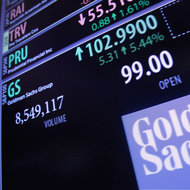Apple Inc slid 5.5 percent to $402.80 after falling below $400 for the first time since December 2011. A key supplier, chipmaker Cirrus Logic, gave a disappointing revenue forecast, fueling worries about weakening demand for the iPhone and iPad.
The CBOE Volatility index, a measure of investor anxiety, jumped 18.3 percent to 16.51. It remains well below the 20 mark, however, suggesting market volatility is still considered relatively subdued.
Wednesday’s losses were the week’s second big sell-off, adding to views the market may be starting the pullback analysts have been speculating about for months. The market has had strong gains since the start of year, yet on Monday, the SP 500 posted its worst day since November 7 following a sharp drop in gold prices.
“After Monday’s gold selloff spooked U.S. equities, it seems as though the dip buyers are a bit less aggressive, allowing the market to fall a bit more,” said Gordon Charlop, a managing director at Rosenblatt Securities in New York.
“This could also be indicative of a muted risk tolerance and perhaps mark the beginning of a long-awaited equity pullback.”
The Dow Jones industrial average was down 138.19 points, or 0.94 percent, at 14,618.59. The Standard Poor’s 500 Index was down 22.56 points, or 1.43 percent, at 1,552.01. The Nasdaq Composite Index was down 59.96 points, or 1.84 percent, at 3,204.67.
Volume was roughly 7.89 billion shares traded on the New York Stock Exchange, the Nasdaq and the NYSE MKT, well above the average daily closing volume of about 6.36 billion this year. Decliners outpaced advancers by nearly 4 to 1 on both the NYSE and the Nasdaq.
Financial stocks also fell after Bank of America Corp posted revenue and profits that were below Wall Street expectations. Shares of the Dow component slumped 4.7 percent to $11.70.
The SP financial index was down 1.9 percent and shares of Morgan Stanley, due to report Thursday, were down 1.7 percent.
Besides financials and technology, energy and materials sectors fell sharply along with oil and copper prices. The SP 500 energy companies fell 1.9 percent and shares of Chevron slid 1.9 percent to $114.81 and helped lead declines on the Dow.
As Apple shares moved lower, the stock’s implied volatility shot higher, reflecting more risk for the stock in the next 30 days.
“This continues a trend since December 2012 where the risk paradigm in Apple has changed,” said Ophir Gottlieb, managing director of San-Francisco-based options analytics Livevol.
In a notable technical move, the SP 500 came close to falling below its 50-day moving average. It has not fallen below the level since the end of last year.
Among other tech decliners, Texas Instruments shed 4.3 percent to $34.21. Yahoo Inc declined 0.4 percent to $23.70 after the Internet company reported first-quarter revenue that missed expectations, though many Wall Street analysts raised their price targets on the stock.
SP 500 earnings are now expected to have risen 1.7 percent in the first quarter, based on actual results from 56 companies and estimates for the rest, according to Thomson Reuters data.
That expectation is up from a previous estimate of 1.5 percent growth at the start of the month, but so far just 48.2 percent of companies this reporting period have beaten revenue expectations.
After the closing bell, shares of eBay and memory chipmaker SanDisk fell after reporting results. EBay was down 2.3 percent at $54.80 while shares of SanDisk were down 3.1 percent at $54.
Adding to uncertainty in the market, authorities said a letter sent to President Barack Obama and intercepted at a mail screening facility contained the deadly poison ricin, according to preliminary testing.
“The ongoing sequence of these terrorist incidents … doesn’t create an environment for good investor psychology,” said Bucky Hellwig, senior vice president at BBT Wealth Management in Birmingham, Alabama.
(Additional reporting by Doris Frankel and Chuck Mikolajczak; Editing by Kenneth Barry and Nick Zieminski)
Article source: http://www.nytimes.com/reuters/2013/04/17/business/17reuters-markets-stocks.html?partner=rss&emc=rss
